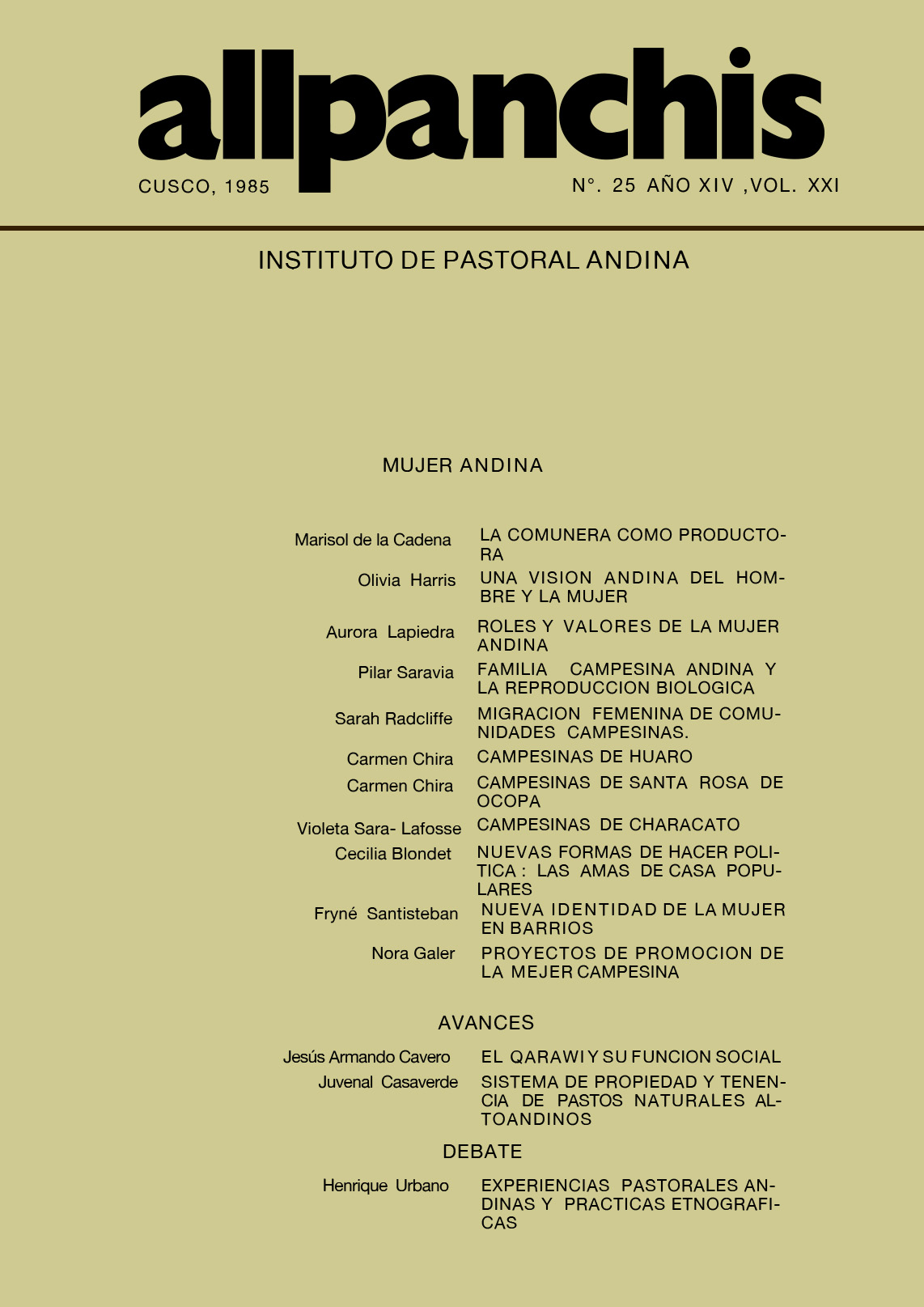Complementariedad y conflicto
Una visión andina del hombre y la mujer
DOI:
https://doi.org/10.36901/allpanchis.v17i25.1031Palabras clave:
visión andina, roles de género, conflictividad, complementariedadResumen
El análisis de los sistemas conceptuales binarios incluye a "hombre y a mujer" como paradigmas de categorías opuestas. En muchas culturas, el uso de las categorías "mujer y hombre", para facilitar el pensamiento, parecer ser parte de un sistema de ordenación en el que la mujer se encuentra ubicada en el lado menos valorado e inferir de la oposición. Es así que algunos autores han sugerido que la mujer es al hombre, lo que la naturaleza es a la cultura. Otros han llamado la atención sobre la forma cómo se usa la mano izquierda o derecha para expresar las diferencias de género, en palabras de Evans Pritchard, "una leve asimetría orgánica se vuelve símbolo de una absoluta polaridad moral" (1973).
Descargas
Referencias
Albó, X. (1973). Esposos, Suegros y Padrinos, Cuadernos CIPCA, La Paz.
Ardener, E. (1971). Belief and the Problem of Women, in “The Interpretation of Ritual” (ed. J. La Fontaine). Tavistock, Londres.
Brown, J. (1970). A note on the Division of Labour by Sex, Am.Anth. 71(5), pp. 1073-78.
Chayanov, A. V. (1966). The Theory of Peasant Economy(eds. Basile Kerblay Daniel Thorner and R.E.F. Smith). Homewood, Ill.
Evans-Pritchard, E. E. (1973). Nuer Spear Symbolism, in (ed. R. Needham).
EDHOLM, E., HARRIS, O. and YOUNG K. (1977). Conceptualising Women, Critique of Anthropology, 3(9/10), pp. 101-130.
Fortun, J. E. (1972). a Mujer Aymara en Bolivia, América Indigena, 32(3), pp. 935-947.
Granet, K. (1973). Right and Left in China, in (ed. R. Needham).
Hanmer, J. (1977). Violence and the Social Control of Women, Paper presented at the British Sociological Association Annual Meetin, Sheffield, 29 March-1 April.
Harris, O. (1976). Kinship and-the Vertical Economy among the Laymis, in
“Actes du XLII Cong. Int. des Americanistes” (forthcoming).
Harris, O. y Albo, X. (1975). Monteras
y Guardatojos: campesinos y minerosen el norte de Potosí. Cuadernos CIPCA, La Paz.
Isbell, B. J. (1978). To Defend Ourselves: a view through the Andean. Kaleidoscope. University Press, Texas.
Lambert, B. (1978). Bilaterality in the Andes, in “Andean Kinship and Marriage”. Harvard University Press, Cambridge, Mass.
Michaelson, E. y Goldschmidt, W. (1971). Female Roles and Male Dominance among Peasant, S.
West J. Anthrop., 27(4), 330-352.
Murra, John V. (1967). On Inca Political Structure, in “Comparative Political Systems”” (eds. R. Cohen and J. Middleton). Am.Mus. Sourcebooks in Anth., Natural History Press, New York.
Murra, John V. (1975). Formaciones Económicas y Políticas del Mundo andino. Lima: Instituto de Estudios Peruanos.
Needham, R. (ed.). (1973). Right and Left: Essays on Dual Symbolic. Classification. University Press, Chicago.
Ortners, S. (1974). Is female to male as nature is to culture? in “Woman, Culture and Society” (eds. M.Rosaldo and L. Lamphere). University Press, Stanford.
Platt, T. (1976). Espejos y Mais: temas de la estructura simbólica andina.
Cuadernos CIPCA La Paz.
Sahlins, M. (1974). Stone Age Economics. Tavistock Publ., Londres.
Shanin, T. (1972). The Awkward Class. Clarendon Press, Oxford.
Silverblatt, I. (s. f.). The Position of Womenin the Inca Empire and the Effect on Women's Status of Spanish Colonialism, Thesis proposal, University of Illinois.
Willis, R. (1967). The Head and the Loins, Man (n.S.), vol. 2, núm. 4, pp. 519-534.
Wolf, Eric (1966). Peasants. Prentice Hall Inc., Englewood Cliffs.
Descargas
Publicado
Número
Sección
Licencia
Derechos de autor 1985 Olivia Harris

Esta obra está bajo una licencia internacional Creative Commons Atribución 4.0.
Los trabajos publicados están sujetos a la licencia de Creative Commons versión 4.0 bajo las siguientes condiciones: CC-by: Se permite la posibilidad de copiar, distribuir, exhibir, y producir obras derivadas, siempre y cuando se reconozca y cite al autor y la fuente correctamente.
Los lectores pueden acceder gratuitamente a los contenidos de la revista siempre que no vulneren las restricciones anteriormente explicadas.
Los autores mantienen sus derechos de autor (copyright) al publicar en Allpanchis. Ceden, a su vez, por un periodo de 10 años los derechos de publicación (publishing rights) de la versión aceptada (accepted version) y publicada (published version) para la publicación impresa en el número acordado y de manera virtual sin límite de tiempo. En caso los autores u otroa editores deseen republicar el artículo, se debe solicitar el permiso necesario de Allpanchis. Sucedida esa situación, se agradece remitir la información de la republicación (un ejemplar impreso o, si es solamente virtual, el respectivo enlace).
Los autores pueden guardar el archivo de las versiones enviadas (submitted version), aceptada (accepted version) y publicada (published version) en modalidad de autorarchivo, en repositorios institucionales, temáticos o sitios web personales).





